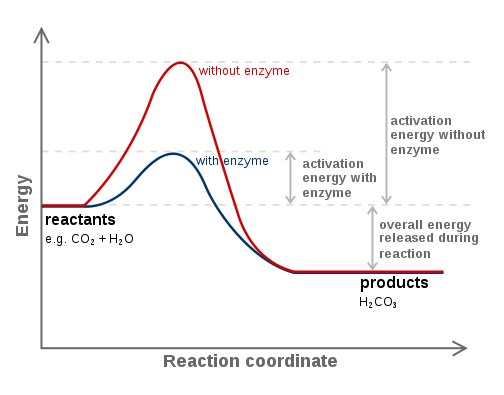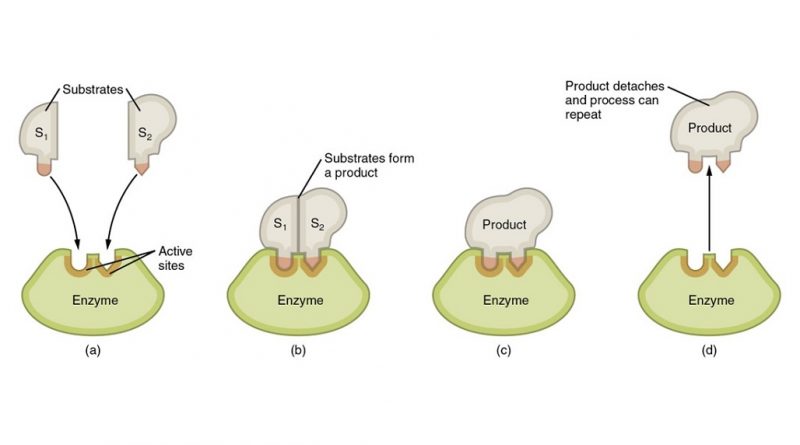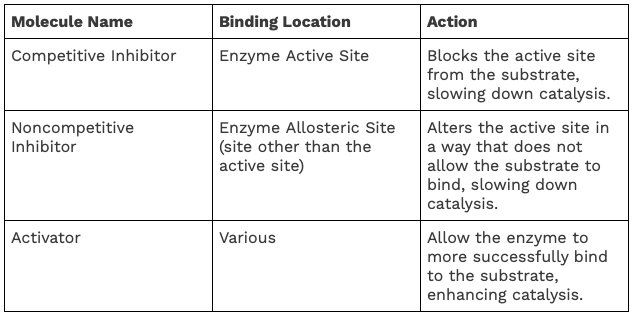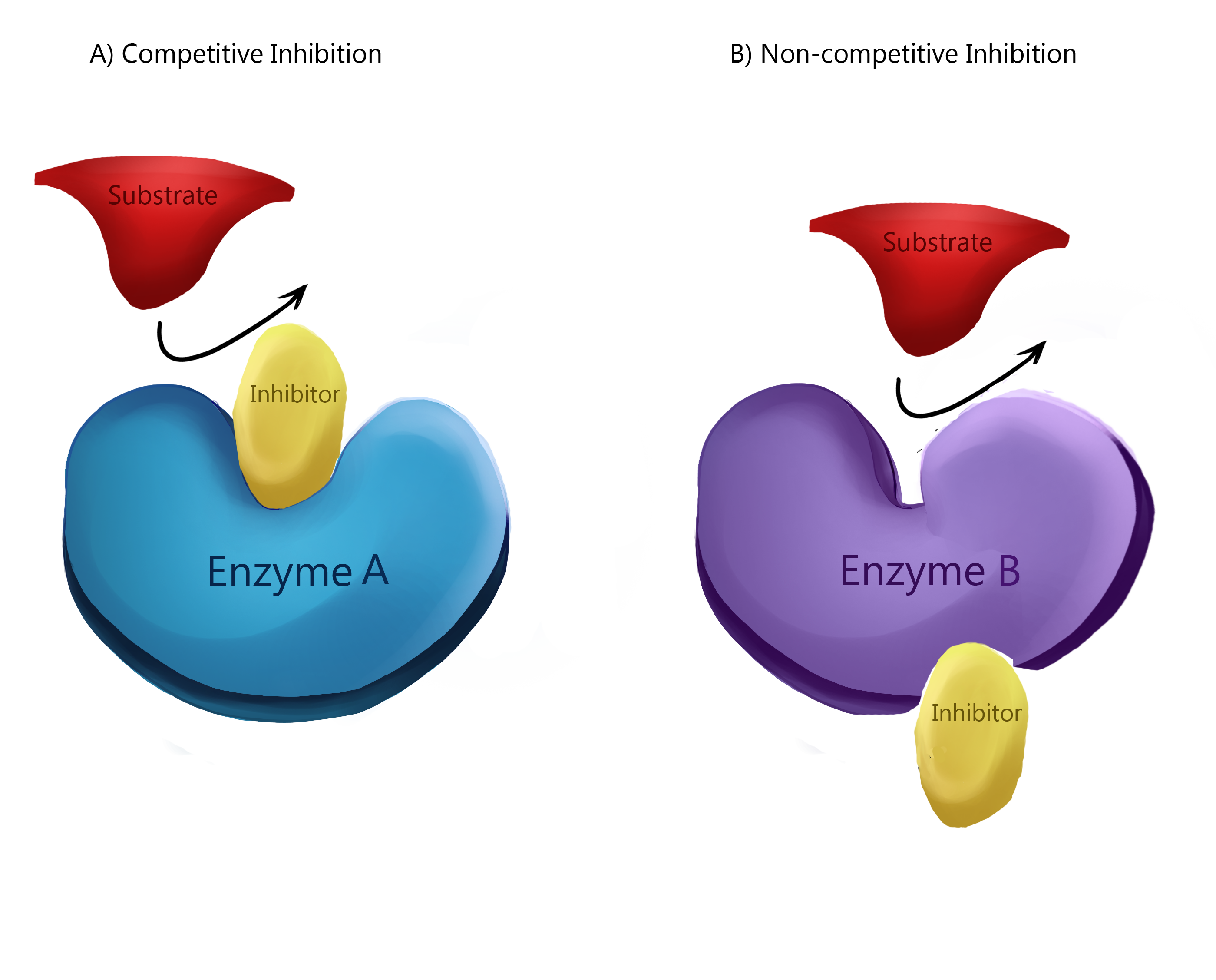
3.2 Enzyme Catalysis
5 min read•january 13, 2023
Caroline Koffke
Jed Quiaoit
Caroline Koffke
Jed Quiaoit
Remember… Constant Energy Input!
The highly complex organization of living systems refers to the many different processes that occur within cells and organisms, such as , , and . These processes involve the participation of many different , including , which catalyze and are essential for maintaining the proper functioning of the cell or organism.
Enzyme plays an important role in the highly complex organization of living systems by allowing the cell to perform its functions more efficiently. For example, catalyze the breakdown of nutrients to generate energy, the synthesis of such as , , and , and the transfer of information between molecules. 🧬
This efficiency allows living systems to perform the wide range of necessary to sustain life while maintaining a relatively steady state, through constant input of energy and the exchange of .
The constant input of energy is necessary to keep the functioning and also to power the that catalyze. can be thought of as molecular machines that need energy to work properly, and their activity is usually coupled with energy-consuming reactions such as the transfer of electrons, proton, or . 🤖
The exchange of is another important aspect of the highly complex organization of living systems. , such as and , are constantly being synthesized, degraded, and recycled. play an important role in this process by catalyzing the synthesis and breakdown of these molecules.
The turnover of these molecules is crucial for maintaining the balance of the cell, the and the response to the environment!
Hold up! What is Catalysis?
Simply put, is the process by which a speeds up a chemical reaction. 🏃💨
Catalysts work by providing an alternative reaction pathway with a lower . In other words, catalysts can make a reaction proceed faster by providing an easier way for the to transform into . They can do this by:
Changing the relative positions of atoms in the , making it easier for them to form the .
Stabilizing the intermediate or , making the reaction proceed more smoothly.
Providing an alternative and more favorable transition state for the reaction to proceed.

Source: Wikimedia Commons
How Does This Relate to Enzymes?
are that catalyze in cells. Just like any other in other disciplines, they do this by lowering the (the amount of energy required for a reaction to proceed) of the reaction they catalyze. This allows the reaction to occur more quickly and efficiently.
are specific for the reactions they catalyze and the substrates (remember: substrates = ) they act on. They do this by having a unique three-dimensional structure that allows them to bind to the substrates in a specific way, a process called . This binding forms an intermediate complex called the , which is more reactive than the substrate alone. 🧊

Source: Baylor College of Medicine
As the enzyme catalyzes the reaction, the substrate is converted into , which then dissociate from the enzyme, leaving it free to bind to another substrate molecule. can be reused several times in this way.
The rate of an enzyme-catalyzed reaction is affected by several factors, including the concentration of substrate, the presence of or , and the temperature and pH of the environment.
An increase in substrate concentration can lead to an increase in the rate of an enzyme-catalyzed reaction, up to a certain point, after which the rate levels off. This is known as the .
are molecules that bind to and decrease the rate of reaction. They can do this by binding to the active site of the enzyme and preventing substrate binding, or by altering the shape of the enzyme so it cannot bind to the substrate.
are molecules that bind to and increase the rate of reaction. They can do this by increasing the stability of the , making it more likely that the substrate will bind to the enzyme.
The temperature and pH of the environment also affect enzyme activity. Most have an and pH at which they function best. At temperatures or pHs outside this range, the enzyme may become denatured, or lose its shape, and can no longer function.
Competitive and Noncompetitive Inhibitors
A few substances act to inhibit or activate the processes of . While there are many environmental factors that can alter an enzyme’s ability to function, explained next, there are also certain molecules that can act to change the process as well. A chart of these molecules is shown below. 😡


Source: WikiMedia Commons.
Test Your Knowledge
A scientist wants to study the effect of pH on the activity of an enzyme called "Protein X." He prepares a solution of the enzyme at a concentration of 0.1 mg/mL and adds it to a reaction mixture containing the substrate for the enzyme. He then measures the rate of the reaction at different pH levels. The table below shows his results.
pH | Reaction Rate (mM/min) |
7.0 | 0.10 |
7.5 | 0.15 |
8.0 | 0.20 |
8.5 | 0.15 |
9.0 | 0.10 |
Based on these results, answer the following questions:
At which pH level is the enzyme most active?
How does the activity of the enzyme change as the pH deviates from its optimal range?
How would the activity of the enzyme be affected if the pH deviated too far from the optimal range? What sort of changes to the enzyme might cause this to occur?
In the living cells, the enzyme is surrounded by a variety of buffers that helps in maintaining the pH, what role do you think buffer play in this enzyme activity?
Answers
The enzyme is most active at pH 8.0
As the pH deviates from its optimal range, the activity of the enzyme decreases.
The activity of the enzyme decreases significantly when the pH deviates too far from the optimal range because have a specific pH range in which they function optimally. If the pH deviates too far from this range, the enzyme may become denatured, or lose its shape, and can no longer function.
Buffers plays an important role in maintaining the pH around , by removing hydrogen ions when the pH becomes too low and adding hydrogen ions when the pH becomes too high, buffers can help to keep the pH in the optimal range for enzyme activity.
Key Terms to Review (32)
Activation Energy
: Activation energy is the minimum amount of energy required to start a chemical reaction.Activators
: Activators are substances that increase the activity of enzymes, speeding up certain reactions in the body.ATP Hydrolysis
: ATP hydrolysis is the process by which water is used to break down ATP (adenosine triphosphate) into ADP (adenosine diphosphate), releasing energy stored in the phosphate bonds.Biomolecules
: Biomolecules are organic molecules produced by living organisms. They include carbohydrates, proteins, lipids, and nucleic acids.Catalysis
: Catalysis is the process by which catalysts speed up chemical reactions without being consumed or altered themselves.Catalyst
: A catalyst is any substance that increases the rate of a chemical reaction by lowering its activation energy but remains unchanged itself after the reaction has occurred.Chemical Reactions
: A chemical reaction is a process that leads to the transformation of one set of chemical substances to another. It involves breaking and forming bonds between atoms.Competitive Inhibitors
: These are molecules that bind to the active site of an enzyme, preventing the substrate from binding and thus inhibiting the enzyme's function.Constant Energy Input
: This refers to the continuous supply of energy required by living organisms to perform various life processes, such as growth, reproduction, and maintenance.Denaturation
: Denaturation is the process by which a protein loses its native shape due to the disruption of weak interactions within the molecule, often caused by changes in temperature or pH.DNA
: DNA (Deoxyribonucleic Acid) is a molecule that carries most of the genetic instructions used in development, functioning and reproduction of all known living organisms.Enzyme Catalysis
: Enzyme catalysis is a process in which enzymes speed up biochemical reactions by lowering the activation energy required for the reaction to occur.Enzyme-Substrate Complex
: This is the intermediate formed when a substrate molecule interacts with the active site of an enzyme.Enzyme-Substrate Recognition
: This refers to how an enzyme recognizes its specific substrate (the molecule upon which an enzyme acts).Enzymes
: Enzymes are biological catalysts that speed up chemical reactions in living organisms without being consumed in the process.Growth
: Growth refers to an increase in size, number or complexity of cells or whole organism over time due to cell division and differentiation.Information Transfer
: In biology, information transfer refers to how genetic information passes from DNA to RNA and then directs the synthesis of proteins.Inhibitors
: Inhibitors are substances that reduce the activity of enzymes, slowing down or even stopping certain reactions in the body.Macromolecules
: Large complex molecules that make up living organisms; they include carbohydrates, proteins, lipids (fats), and nucleic acids.Metabolism
: Metabolism refers to all chemical reactions involved in maintaining the living state of cells and organisms. It can be divided into two categories - catabolism (breaking down molecules) and anabolism (building up molecules).Noncompetitive Inhibitors
: Noncompetitive inhibitors are molecules that bind to an area other than an enzyme's active site, changing its shape so it can no longer effectively catalyze reactions with its normal substrates.Nucleic Acids
: Nucleic acids are large biomolecules essential for all known forms of life. They include DNA (deoxyribonucleic acid) and RNA (ribonucleic acid), which carry genetic information.Optimal pH
: Optimal pH refers to the specific value at which a particular enzymatic reaction occurs at its maximum rate. It varies for different enzymes based on their environment and nature.Optimal Temperature
: This is the temperature at which any given biological system operates most efficiently for maximum productivity or speed.Products
: Products are substances formed as results of a chemical reaction from reactants.Protein Synthesis
: Protein synthesis is the process by which cells build proteins. This involves two main stages - transcription (where DNA is converted into RNA) and translation (where RNA is used to produce proteins).Proteins
: Large biomolecules consisting of one or more long chains of amino acid residues. Proteins perform a vast array of functions within organisms.Reactants
: Reactants are substances present at the beginning of a chemical reaction which are consumed during the process.Reproduction
: Reproduction is the biological process by which new individuals of the same species are produced, either by a single parent (asexual reproduction) or two parents (sexual reproduction).RNA
: RNA (Ribonucleic Acid) is a molecule similar to DNA that plays a crucial role in protein synthesis and other chemical activities of the cell.Saturation Point
: The saturation point is the stage at which, under given conditions, a substance cannot absorb or dissolve any more of another substance.Transition States
: The transition state in a chemical reaction is a particular configuration along the reaction path. It is defined as the state corresponding to the highest potential energy along this path.3.2 Enzyme Catalysis
5 min read•january 13, 2023
Caroline Koffke
Jed Quiaoit
Caroline Koffke
Jed Quiaoit
Remember… Constant Energy Input!
The highly complex organization of living systems refers to the many different processes that occur within cells and organisms, such as , , and . These processes involve the participation of many different , including , which catalyze and are essential for maintaining the proper functioning of the cell or organism.
Enzyme plays an important role in the highly complex organization of living systems by allowing the cell to perform its functions more efficiently. For example, catalyze the breakdown of nutrients to generate energy, the synthesis of such as , , and , and the transfer of information between molecules. 🧬
This efficiency allows living systems to perform the wide range of necessary to sustain life while maintaining a relatively steady state, through constant input of energy and the exchange of .
The constant input of energy is necessary to keep the functioning and also to power the that catalyze. can be thought of as molecular machines that need energy to work properly, and their activity is usually coupled with energy-consuming reactions such as the transfer of electrons, proton, or . 🤖
The exchange of is another important aspect of the highly complex organization of living systems. , such as and , are constantly being synthesized, degraded, and recycled. play an important role in this process by catalyzing the synthesis and breakdown of these molecules.
The turnover of these molecules is crucial for maintaining the balance of the cell, the and the response to the environment!
Hold up! What is Catalysis?
Simply put, is the process by which a speeds up a chemical reaction. 🏃💨
Catalysts work by providing an alternative reaction pathway with a lower . In other words, catalysts can make a reaction proceed faster by providing an easier way for the to transform into . They can do this by:
Changing the relative positions of atoms in the , making it easier for them to form the .
Stabilizing the intermediate or , making the reaction proceed more smoothly.
Providing an alternative and more favorable transition state for the reaction to proceed.

Source: Wikimedia Commons
How Does This Relate to Enzymes?
are that catalyze in cells. Just like any other in other disciplines, they do this by lowering the (the amount of energy required for a reaction to proceed) of the reaction they catalyze. This allows the reaction to occur more quickly and efficiently.
are specific for the reactions they catalyze and the substrates (remember: substrates = ) they act on. They do this by having a unique three-dimensional structure that allows them to bind to the substrates in a specific way, a process called . This binding forms an intermediate complex called the , which is more reactive than the substrate alone. 🧊

Source: Baylor College of Medicine
As the enzyme catalyzes the reaction, the substrate is converted into , which then dissociate from the enzyme, leaving it free to bind to another substrate molecule. can be reused several times in this way.
The rate of an enzyme-catalyzed reaction is affected by several factors, including the concentration of substrate, the presence of or , and the temperature and pH of the environment.
An increase in substrate concentration can lead to an increase in the rate of an enzyme-catalyzed reaction, up to a certain point, after which the rate levels off. This is known as the .
are molecules that bind to and decrease the rate of reaction. They can do this by binding to the active site of the enzyme and preventing substrate binding, or by altering the shape of the enzyme so it cannot bind to the substrate.
are molecules that bind to and increase the rate of reaction. They can do this by increasing the stability of the , making it more likely that the substrate will bind to the enzyme.
The temperature and pH of the environment also affect enzyme activity. Most have an and pH at which they function best. At temperatures or pHs outside this range, the enzyme may become denatured, or lose its shape, and can no longer function.
Competitive and Noncompetitive Inhibitors
A few substances act to inhibit or activate the processes of . While there are many environmental factors that can alter an enzyme’s ability to function, explained next, there are also certain molecules that can act to change the process as well. A chart of these molecules is shown below. 😡


Source: WikiMedia Commons.
Test Your Knowledge
A scientist wants to study the effect of pH on the activity of an enzyme called "Protein X." He prepares a solution of the enzyme at a concentration of 0.1 mg/mL and adds it to a reaction mixture containing the substrate for the enzyme. He then measures the rate of the reaction at different pH levels. The table below shows his results.
pH | Reaction Rate (mM/min) |
7.0 | 0.10 |
7.5 | 0.15 |
8.0 | 0.20 |
8.5 | 0.15 |
9.0 | 0.10 |
Based on these results, answer the following questions:
At which pH level is the enzyme most active?
How does the activity of the enzyme change as the pH deviates from its optimal range?
How would the activity of the enzyme be affected if the pH deviated too far from the optimal range? What sort of changes to the enzyme might cause this to occur?
In the living cells, the enzyme is surrounded by a variety of buffers that helps in maintaining the pH, what role do you think buffer play in this enzyme activity?
Answers
The enzyme is most active at pH 8.0
As the pH deviates from its optimal range, the activity of the enzyme decreases.
The activity of the enzyme decreases significantly when the pH deviates too far from the optimal range because have a specific pH range in which they function optimally. If the pH deviates too far from this range, the enzyme may become denatured, or lose its shape, and can no longer function.
Buffers plays an important role in maintaining the pH around , by removing hydrogen ions when the pH becomes too low and adding hydrogen ions when the pH becomes too high, buffers can help to keep the pH in the optimal range for enzyme activity.
Key Terms to Review (32)
Activation Energy
: Activation energy is the minimum amount of energy required to start a chemical reaction.Activators
: Activators are substances that increase the activity of enzymes, speeding up certain reactions in the body.ATP Hydrolysis
: ATP hydrolysis is the process by which water is used to break down ATP (adenosine triphosphate) into ADP (adenosine diphosphate), releasing energy stored in the phosphate bonds.Biomolecules
: Biomolecules are organic molecules produced by living organisms. They include carbohydrates, proteins, lipids, and nucleic acids.Catalysis
: Catalysis is the process by which catalysts speed up chemical reactions without being consumed or altered themselves.Catalyst
: A catalyst is any substance that increases the rate of a chemical reaction by lowering its activation energy but remains unchanged itself after the reaction has occurred.Chemical Reactions
: A chemical reaction is a process that leads to the transformation of one set of chemical substances to another. It involves breaking and forming bonds between atoms.Competitive Inhibitors
: These are molecules that bind to the active site of an enzyme, preventing the substrate from binding and thus inhibiting the enzyme's function.Constant Energy Input
: This refers to the continuous supply of energy required by living organisms to perform various life processes, such as growth, reproduction, and maintenance.Denaturation
: Denaturation is the process by which a protein loses its native shape due to the disruption of weak interactions within the molecule, often caused by changes in temperature or pH.DNA
: DNA (Deoxyribonucleic Acid) is a molecule that carries most of the genetic instructions used in development, functioning and reproduction of all known living organisms.Enzyme Catalysis
: Enzyme catalysis is a process in which enzymes speed up biochemical reactions by lowering the activation energy required for the reaction to occur.Enzyme-Substrate Complex
: This is the intermediate formed when a substrate molecule interacts with the active site of an enzyme.Enzyme-Substrate Recognition
: This refers to how an enzyme recognizes its specific substrate (the molecule upon which an enzyme acts).Enzymes
: Enzymes are biological catalysts that speed up chemical reactions in living organisms without being consumed in the process.Growth
: Growth refers to an increase in size, number or complexity of cells or whole organism over time due to cell division and differentiation.Information Transfer
: In biology, information transfer refers to how genetic information passes from DNA to RNA and then directs the synthesis of proteins.Inhibitors
: Inhibitors are substances that reduce the activity of enzymes, slowing down or even stopping certain reactions in the body.Macromolecules
: Large complex molecules that make up living organisms; they include carbohydrates, proteins, lipids (fats), and nucleic acids.Metabolism
: Metabolism refers to all chemical reactions involved in maintaining the living state of cells and organisms. It can be divided into two categories - catabolism (breaking down molecules) and anabolism (building up molecules).Noncompetitive Inhibitors
: Noncompetitive inhibitors are molecules that bind to an area other than an enzyme's active site, changing its shape so it can no longer effectively catalyze reactions with its normal substrates.Nucleic Acids
: Nucleic acids are large biomolecules essential for all known forms of life. They include DNA (deoxyribonucleic acid) and RNA (ribonucleic acid), which carry genetic information.Optimal pH
: Optimal pH refers to the specific value at which a particular enzymatic reaction occurs at its maximum rate. It varies for different enzymes based on their environment and nature.Optimal Temperature
: This is the temperature at which any given biological system operates most efficiently for maximum productivity or speed.Products
: Products are substances formed as results of a chemical reaction from reactants.Protein Synthesis
: Protein synthesis is the process by which cells build proteins. This involves two main stages - transcription (where DNA is converted into RNA) and translation (where RNA is used to produce proteins).Proteins
: Large biomolecules consisting of one or more long chains of amino acid residues. Proteins perform a vast array of functions within organisms.Reactants
: Reactants are substances present at the beginning of a chemical reaction which are consumed during the process.Reproduction
: Reproduction is the biological process by which new individuals of the same species are produced, either by a single parent (asexual reproduction) or two parents (sexual reproduction).RNA
: RNA (Ribonucleic Acid) is a molecule similar to DNA that plays a crucial role in protein synthesis and other chemical activities of the cell.Saturation Point
: The saturation point is the stage at which, under given conditions, a substance cannot absorb or dissolve any more of another substance.Transition States
: The transition state in a chemical reaction is a particular configuration along the reaction path. It is defined as the state corresponding to the highest potential energy along this path.
Resources
© 2024 Fiveable Inc. All rights reserved.
AP® and SAT® are trademarks registered by the College Board, which is not affiliated with, and does not endorse this website.